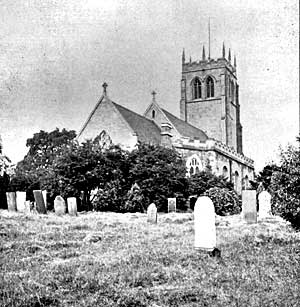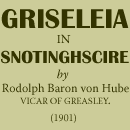< Previous | Contents | Next >

St. Mary Greasley, North East.
Another testamentary burial in Greasley Church is mentioned in the Torre Manuscripts. We have noticed in Watnall the name of a Chamberlain as one of the witnesses to a document, and we conclude that one of that family entered the Church and rose to some ecclesiastical dignity, otherwise we should not know how to account for the “Torre” Notice. It is as follows :— “12th June, 1446. Joh. Chamberlayn, Archdeacon of Notts, to be buried in the Chancel of the Church of Greasley.”
We have, among others, through the kind aid of Mr. W. P. W. Phillimore, seen the original document at the Public Record Office, of the inventory of the goods of Greasley Church in the reign of Edward VI. It is on an irregular scrap of parchment fastened on a page of a folio Volume (Acy. Misc. Book, 507), and is as follows:— “This inventore made ye V. Daye of September, VI. yeyre of Edwarde ye VI. be ye grase of good of yngland Frannce and yrland diffendor of ye Fayth and of ye Chyrche of yngland and allso of yrland ye suppreme had.”
1st. Imprymis a challys wth. ye patten of sylver gylt.
Item. ii. bellys in ye Steppyll.
Item. ii. coppys on branchyd wth. blew ye hother. wth. grene.
Item. iii. vestementes on of thame ys blake chamlet wth. ye crosse of ye bake of greyne vellvet.
It. Ye second of Tham ye of grene wth. ye crosse of ye bake of Chamlet.
It. Thred of thame ys of goyld wth. a crosse of ye bak wth. blewe and rede.
be me Richard Hallam, Vicar ibidem. John gallale, Richard Folwood, Jhon [Blake?],
Wyllam Shyppard [Churchwardens].
Md. John Galleley and his followers are bound by ... to answer for a bell wch. they have sold for X. li
The reading of the document is as follows :—
It. Imprimis a chalice with the paten of silver gilt.
Item. 2 bells in the steeple.
Item. 2 copes, one branched (i.e., broidered) in blue, the other green.
Item. 3 vestments, one of them is of black chamlet, with the cross of the back in green velvet.
It. The second of them is of green, with the cross of the back in chamlet.
It. Third of them is of gold, with a cross of the back in blue and red.
The words which in the copy from the original are placed in brackets were not clearly legible.
Chamlet was the name probably given to a material much used at that time for ecclesiastical vestments.
The Churchwardens had evidently done away with one of the bells, by sale, since the Commissioners, according to the memorandum appended to the inventory, made a note of it, and bound them over to answer for it.
The Tower of Greasley Church comes next in age after the Chancel, and from its west window appears to point to the perpendicular type, which is reputed to have lasted from about 1377 to 1509. Possibly the tower was built on the site of a former crumbling one of Saxon date by Nicholas de Canteloupe, or perhaps by the La Zouches who succeeded the De Canteloupes, but not later. The gurgoyles of the tower waterspouts are hideous in their representation of deformed and leprosy stricken countenances of human heads. Tyack writes that in olden times of superstition they were supposed to keep evil spirits out of the sacred edifice. The tower has eight crocketed well-proportioned pinnacles and is embattled. The same kind of embattlement is also on the walls of the nave, and the material of all the battlements, together with that of the tower and of the buttresses (except those of the chancel, which are modern) is of very good and durable stone.
There were in 1866 four bells in the tower. We have read of two of them in the inventory of church goods which was taken in Edward VI.’s time. The churchwardens of that time, who were by the Commissioners made answerable for the third bell, probably replaced one for that which they had sold, and a fourth one was added in 1773. This fourth bell may have been cast in our churchyard or in some place close by, because on the occasion of a difference of much later years about the west fence of the old vicarage grounds, an aged man came forward as a witness, who stated that in earlier years of his life he had been engaged to renew that fence ditch, in which he discovered a quantity of bell metal refuse. We found two of these four bells cracked in 1866, and the other two needed re-clappering and re-hanging. The work was entrusted to Messrs. J. Taylor & Co., Bell-founders, of Loughborough, together with the addition of a fifth bell, and they restored the whole peal in a most satisfactory manner. The bells were carefully described in the Reliquary, vol. 19, p. 170. The first, fourth, and fifth were as stated cast by Messrs. J. Taylor & Co. in 1869. The second in the peal is the one supposed to have been cast in our churchyard, and bears the inscription :—
* O O |__| G. HEDDERN OF NOTTINGHAM MADE ME 1793.
There is a star before this legend, followed by two coin impressions and a guilloche or piece of pattern border.
The last of the five bells is the third in the peal and is a rare pre-Reformation bell in black letters, of the finest and purest tone. The inscription is in Old English letters with Lombardic capitals, which are much smaller than the others, and the circular medallion-like divisions between the words represent the founder’s marks, i.e., Dulcis O Sisto O Malis O Vocor O Campana O Gabrielis O William O Founder.
Translate that puzzle who can. So far the best rendering has been by a clergyman, whose name has escaped our memory. “I am a bell of sweet sound. I am called Gabriel.”
We know nothing of Greasley Church repairs or restorations until the year 1727, when William Warburton was Vicar. We know neither what the works of that restoration embraced, except that the roof of the Church was lowered and roofed with lead. A piece of the lead was cut out of it in 1897 which bore the inscription (in raised letters): Sir Robert Sutton, Improprietor, 1727. It is now preserved as a relic of the past in the Tower porch.
Another restoration of which until very lately we knew nothing must have been an important one, the estimated cost of which was £1,530. That was in the year 1753, and the funds for it were raised “Upon Briefe.”
The authorities of the Parish Church of Chatham have a carefully preserved list of the Briefs, in compliance with which collections were made in that Church from 1663 to May 5th, 1791, and the collection for Greasley Church was made there on the 15th of April, 1753. The Revd. G. S. Tyack gives the following explanation :—When a public appeal had to be made for funds, the usual method in past ages was by means of briefs. The word was applied originally to a form of pontifical letter issued by the Pope, somewhat less solemn and weighty in character than a bull. It came latterly in England to be used of letters patent issued by the Sovereign, authorizing and recommending the collection of alms on behalf of a specified cause, &c. Briefs, both in the legal and the popular sense, were often issued for the building and the repair of churches.
Dr. J. C. Cox gives the further information that: the repair or rebuilding of churches in past reformation days, until nearly the beginning of the Catholic revival, was almost invariably effected by briefs. About the middle of last century, owing to the growing frequency of briefs, it was ordered that they should only be granted on the formal application of Quarter Sessions, &c. The briefs themselves were issued from the Court of Chancery until 1828, when they were abolished. The brief for Greasley was owing to the need of church repairs (not fire) which were estimated to cost, as above stated, £1,530; an experience which the Church of Eastwood had likewise to make some six years later to raise (in 1760) the sum of £1,200. Whatsoever the repairs of our church may have effected in 1753 (of which we have no particulars) there were again repairs of the church in 1832. That restoration was the most unfortunate of all, except that it gave a new lead roof to the chancel.
The church remained practically in the condition then given to it until 1882. A piece of lead cut from the roof in 1897 has in raised letters the words:— “Lord Viscount Melbourne. Improprietor. 1832.” This plate is also preserved in the church porch.
